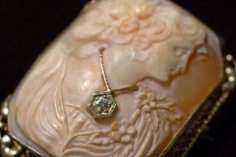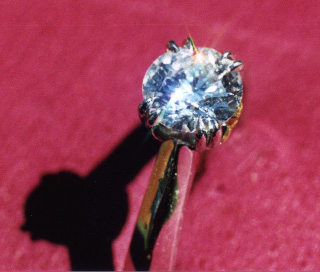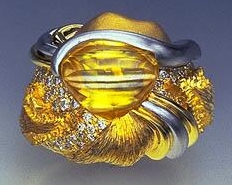
There are so many ways people make a living in America! Some work as engineers and programmers, spending all day in an office. Others work in stores and restaurants that are open from 6 a.m. to midnight. There are jobs cleaning up roadkill… The list goes on. However, we'll focus on the profession of “treasure hunter”—or, more precisely, diamond hunter.
In the state of Arkansas, there's a national park called Crater of Diamonds. It's a small, plowed field of greenish soil where diamonds are found. It's the eighth-largest diamond mine in the world and the only one where you can take home everything you find.
The first diamond was found completely by accident in 1906. Farmer John Peddleston, who had purchased the property, was patrolling his property when he saw something glittering on the side of the trail. He thought it was gold, but it turned out to be a diamond. After crawling around, John quickly found another stone. He sold both diamonds to a jeweler, and a little later sold the land for $36,000, a considerable sum at the time.
Industrial mining began, but met with little success, and in 1972, the state of Arkansas purchased the land for $750,000. A national park was created where anyone could search for diamonds and take home any they found. Every year, people come to the park to try their luck. Some even make diamond prospecting their profession. These people add the prefix “Diamond” to their names—for example, “Diamond” Jim Archer, who spent his entire life prospecting for diamonds in the park and became a local celebrity. Jim made a living selling the diamonds he found and died at the age of 77 right there in the field.
Several large diamonds have been found in the park—the largest, 40 carats, was found in 1924 and named “Uncle Sam.” It is the largest diamond ever found in North America. The next largest is the “Amarillo Starlight” (16.37 carats), found in 1975, followed by the 15-carat “Star of Arkansas,” found in 1956.
Some stones are cut and become diamonds, such as the Strawn-Wagner diamond, discovered by Shirley Strawn in 1990. The rough diamond weighed 3 carats; after cutting, the stone weighed 1.09 carats. It is the most perfect diamond in the world in terms of clarity, color, and cut.
Of the rough stones, the most famous is the Kahn Canary diamond. It is triangular in shape, golden in color, weighs 4.25 carats, and is the symbol of Arkansas. A ring featuring this stone, borrowed from its owner, adorned Hillary Clinton's hand at Bill Clinton's presidential inauguration in 1992, as Arkansas is Bill's birthplace.
The number of diamonds found in the park from 1972 to 2007 is almost 27 thousand, of which 778 weighed more than 1 carat.
It's no surprise that immediately after I came across a mention of the park online, we packed up, booked a place to stay at a hotel with the romantic name “Riverside Retreat,” and went treasure hunting.
The hunt proceeds as follows. First, you need to gather equipment—a bucket, a shovel, and two sieves—one with large mesh and one with small mesh. Then, scoop up some soil in the bucket, take it to the washing station (which consists of large vats of water and tables for examining the “catch”), pour a small amount of soil into the sieves (the large part nested inside the small part), immerse the entire assembly in the vat of water, and, shaking, wash away the soil. The remaining gravel in the sieve is carefully poured onto the table, allowed to dry, and then examined. Anything that sparkles is diamond (or mica—this is determined at the inspection station, where the stones are checked for lice).
After half an hour, I realized two things: first, finding a diamond requires either incredible luck or a lifetime spent searching in the field; second, this was the stupidest thing I'd ever done. Nevertheless, my husband and I continued searching for two hours, making a few changes to the process—we simply poured the washed gravel into a bucket to take home, dry, and examine it (from the park, you can take a handful of soil or 5 kilograms of washed gravel). In two hours, we washed about a kilogram of gravel and left the hunting area with relief, as the temperature soared above 40 degrees Celsius.
Back home in Texas, we dried the gravel. Alas! No luck… But we were left with a jar full of pebbles as a souvenir, and maybe some of them were even lying next to the as-yet-undiscovered diamonds…

Stone-Wagner Diamond

Almaz Kan Kanari





